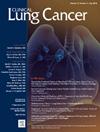无症状或未确诊感染 SARS-CoV-2 的肺癌患者的特征
IF 3.3
3区 医学
Q2 ONCOLOGY
引用次数: 0
摘要
导言严重急性呼吸系统综合征冠状病毒 2(SARS-CoV-2)可能会在不知不觉中传播。这种传播对癌症患者的影响更大,因为他们可能需要经常去医疗机构,接触免疫力低下的疗法,并面临冠状病毒病2019 (COVID-19)的更高发病率。我们确定了肺癌患者中(1)无症状、临床确诊和(2)血清学记录在案但临床未确诊的 SARS-CoV-2 感染者的特征。患者和方法在一个多中心登记处,肺癌患者(无论之前是否接种过 SARS-CoV-2 疫苗或记录在案的感染情况)接受了临床数据收集和连续血样采集,并对血样进行了抗核苷酸蛋白抗体(抗 N Ab)或 IgG(N)水平检测。结果在有血清学证据或临床记录的 SARS-CoV-2 感染者中,80/142(56%)人在首次感染时未报告症状,61/149(40%)人从未被确诊。无症状感染在老年人和早期肺癌患者中更为常见。在多变量分析中,SARS-CoV-2 血清学阳性的非白人患者被临床诊断的可能性降低了 70%(P = .002)。由于此类病例似乎更频繁地发生在可能面临更高的 COVID-19 相关发病率的人群中,因此限制疾病传播和严重程度的措施仍然至关重要。本文章由计算机程序翻译,如有差异,请以英文原文为准。
Characteristics of Lung Cancer Patients With Asymptomatic or Undiagnosed SARS-CoV-2 Infections
Introduction
Severe acute respiratory syndrome coronavirus 2 (SARS-CoV-2) may be spread by individuals unaware they are infected. Such dissemination has heightened ramifications in cancer patients, who may need to visit healthcare facilities frequently, be exposed to immune-compromising therapies, and face greater morbidity from coronavirus disease 2019 (COVID-19). We determined characteristics of (1) asymptomatic, clinically diagnosed, and (2) serologically documented but clinically undiagnosed SARS-CoV-2 infection among individuals with lung cancer.
Patients and methods
In a multicenter registry, individuals with lung cancer (regardless of prior SARS-CoV-2 vaccination or documented infection) underwent collection of clinical data and serial blood samples, which were tested for antinucleocapsid protein antibody (anti-N Ab) or IgG (N) levels. We used multivariable logistic regression models to investigate clinical characteristics associated with the presence or absence of symptoms and the presence or absence of a clinical diagnosis among patients with their first SARS-CoV-2 infection.
Results
Among patients with serologic evidence or clinically documented SARS-CoV-2 infection, 80/142 (56%) had no reported symptoms at their first infection, and 61/149 (40%) were never diagnosed. Asymptomatic infection was more common among older individuals and earlier-stage lung cancer. In multivariable analysis, non-white individuals with SARS-CoV-2 serologic positivity were 70% less likely ever to be clinically diagnosed (P = .002).
Conclusions
In a multicenter lung cancer population, a substantial proportion of SARS-CoV-2 infections had no associated symptoms or were never clinically diagnosed. Because such cases appear to occur more frequently in populations that may face greater COVID-19-associated morbidity, measures to limit disease spread and severity remain critical.
求助全文
通过发布文献求助,成功后即可免费获取论文全文。
去求助
来源期刊

Clinical lung cancer
医学-肿瘤学
CiteScore
7.00
自引率
2.80%
发文量
159
审稿时长
24 days
期刊介绍:
Clinical Lung Cancer is a peer-reviewed bimonthly journal that publishes original articles describing various aspects of clinical and translational research of lung cancer. Clinical Lung Cancer is devoted to articles on detection, diagnosis, prevention, and treatment of lung cancer. The main emphasis is on recent scientific developments in all areas related to lung cancer. Specific areas of interest include clinical research and mechanistic approaches; drug sensitivity and resistance; gene and antisense therapy; pathology, markers, and prognostic indicators; chemoprevention strategies; multimodality therapy; and integration of various approaches.
 求助内容:
求助内容: 应助结果提醒方式:
应助结果提醒方式:


